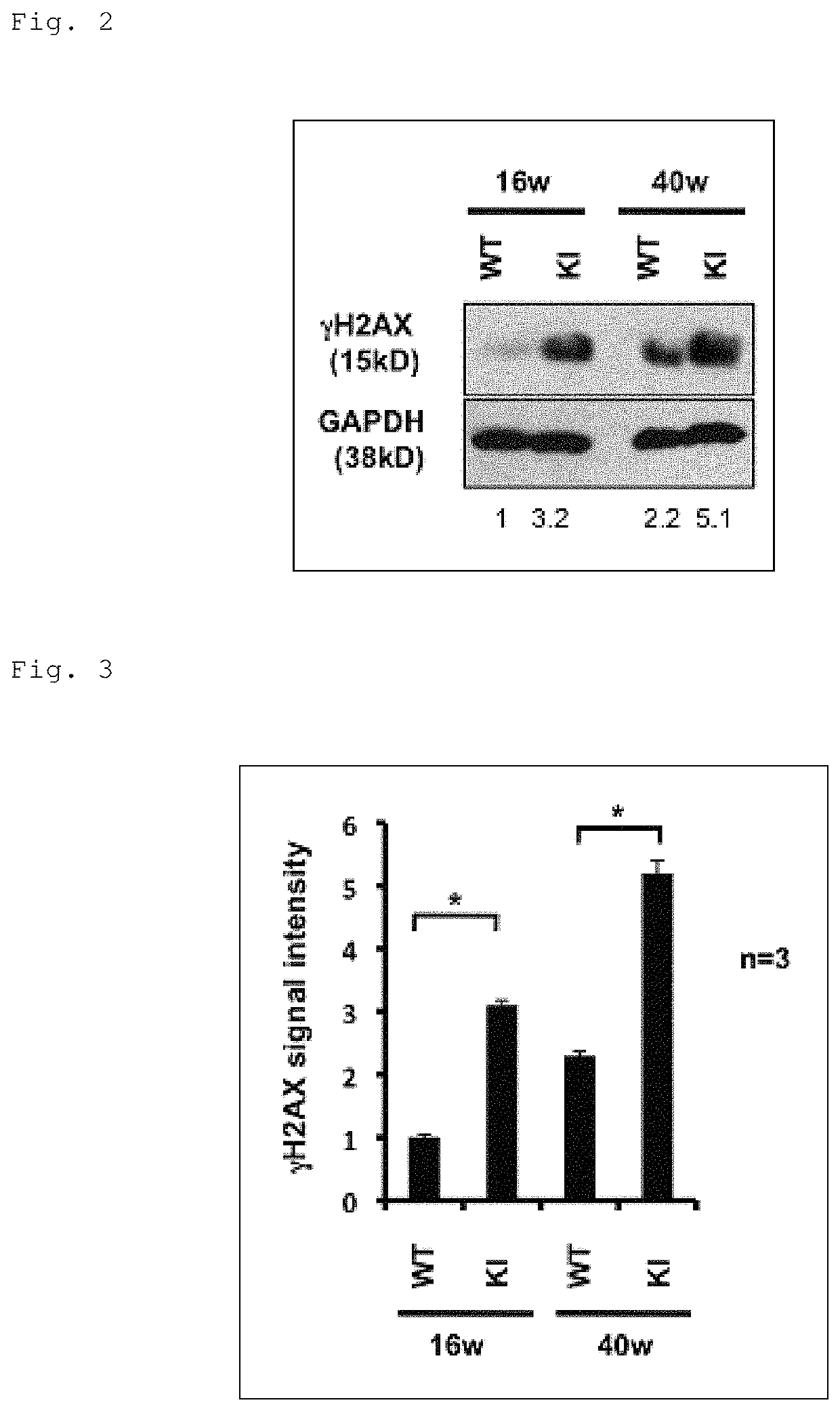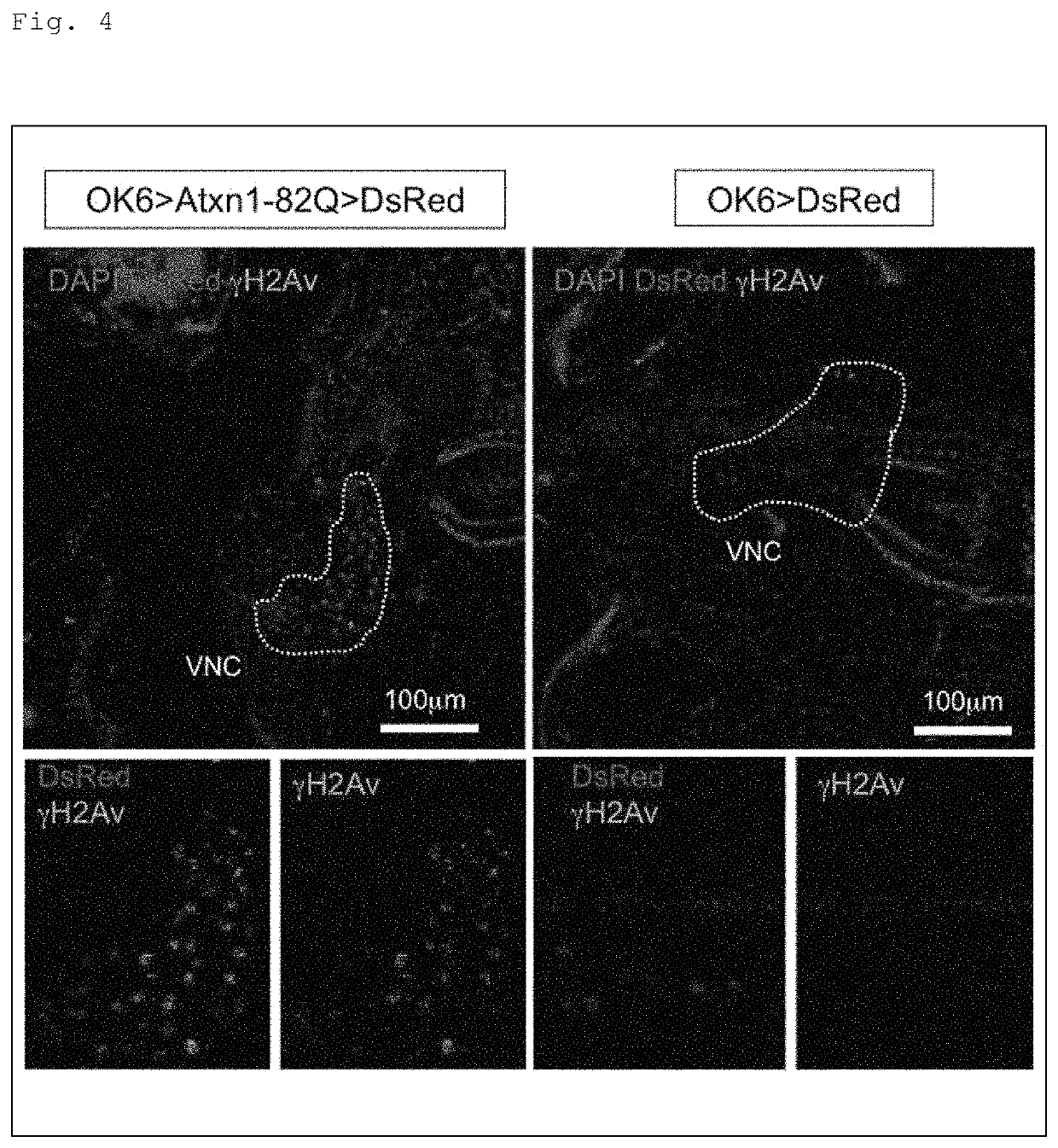Methods for treating spinocerebellar ataxia type I using RPA1
a technology of spinocerebellar ataxia and rpa1 is applied in the field of agents for preventing or treating spinocerebellar ataxia, which can solve the problems of damage repair, no effective method for treating sca, and various biological abnormalities in sca pathology, so as to prevent spinocerebellar ataxia and treat or prevent spinocerebellar ataxia
- Summary
- Abstract
- Description
- Claims
- Application Information
AI Technical Summary
Benefits of technology
Problems solved by technology
Method used
Image
Examples
example 1
[0285]
[0286]The present inventors have revealed that Ku70, which is an important molecule for the DNA double-strand break (DSB)-type DNA repair, restores the shortened lifespan and further improves motor performance of a human Huntington's disease (HD) Drosophila model (UAS-Htt103Q / +:OK6-GAL4 / +Drosophila) (see Tamura, T. et al., PLoS One, 2011, 6, e27408). In addition, the present inventors have also revealed that the function of TERA / VCP / p97, which is another molecule involved in the DSB-type DNA repair, is inhibited in various polyglutamine diseases, and the supplementation of this protein relieves the symptoms of the Drosophila model. Moreover, the present inventors have revealed that DSBs are increased in cerebellar neurons of a spinocerebellar ataxia type 1 (SCA1) mouse model (see Fujita, K. et al., Nat Commun, 2013, 4, 1816).
[0287]As described above, a relation is suggested between DNA damage and polyglutamine diseases, such as SCA and Huntington's disease, caused by the aberr...
example 2
[0290]Drosophila Model>
[0291]Next, a screening system was constructed to identify what type of the DNA repair cascades were involved in the onset of SCA. For the construction of the screening system, the present inventors focused on Drosophila, which has a short generation time and whose phenotypes can be evaluated quantitatively, to appropriately narrow down candidates among various factors and networks in which these factors are involved. Note that the present inventors have revealed the similarity between pathologies of the Drosophila SCA1 model and those of a mammalian SCA1 model on the basis of prior research results.
[0292]In this respect, the present inventors first checked that DSB-type DNA damage was also increased in a Drosophila SCA1 model, as in the case of the mice. Specifically, analysis results of transgenic flies expressing human Atxn1-82Q in motor neurons by using an OK6-Ga14 / UAS system showed increased phosphorylation of H2Av, which is a Drosophila H2AX homolog (see...
example 3
[0304]
[0305]Next, the above-described screening results were analyzed based on systems biology. Specifically, quantitative data on the amelioration by DNA repair genes and protein-protein interaction (PPI) data (BIND, BIOGRID, Cognia, DIP, INTACT, Interactome studies, MINT, and MIPS) were integrated to identify core molecular networks which induced survival time shortening or elongation in the SCA1 fly model. At the same time, a search was conducted for new molecules constituting networks having influences on the lifespan of the Drosophila SCA1 model. More specifically, two algorithms were used for the purpose.
[0306]In a network 1 created by using a first algorithm, protein pathways were selected from the protein-protein interactome (PPI) database, when two gene products exerted any influence on the lifespan directly (Segment 1) or via another protein (Segment 2). In the map of network 1, proteins linked to a larger number of proteins were arranged closer to the center. Moreover, de...
PUM
 Login to View More
Login to View More Abstract
Description
Claims
Application Information
 Login to View More
Login to View More - R&D
- Intellectual Property
- Life Sciences
- Materials
- Tech Scout
- Unparalleled Data Quality
- Higher Quality Content
- 60% Fewer Hallucinations
Browse by: Latest US Patents, China's latest patents, Technical Efficacy Thesaurus, Application Domain, Technology Topic, Popular Technical Reports.
© 2025 PatSnap. All rights reserved.Legal|Privacy policy|Modern Slavery Act Transparency Statement|Sitemap|About US| Contact US: help@patsnap.com



